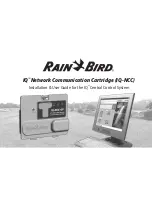
6.10 Troubleshooting without Fault Display
This section describes troubleshooting problems that do not trip an alarm or fault.
The following symptoms indicate that the drive is not set correctly for proper performance with the motor.
Performance Fine-Tuning on page 290
for guidance on troubleshooting.
• Motor hunting and oscillation
• Poor motor torque
• Poor speed precision
• Poor motor torque and speed response
• Motor noise
u
Common Problems
Common Problems
Page
Cannot Change Parameter Settings
Motor Does Not Rotate Properly after Pressing RUN Button
or after Entering External Run Command
Motor Does Not Rotate
Motor Rotates in the Opposite Direction from the Run
Command
Motor Rotates in One Direction Only
Motor is Too Hot
oPE02 Error Occurs When Lowering the Motor Rated Current Setting
Motor Stalls During Acceleration or With Large Loads
Drive Frequency Reference Differs from the Controller Frequency Reference Command
Excessive Motor Oscillation and Erratic Rotation
Deceleration Takes Longer Than Expected with Dynamic Braking Enabled
Noise From Drive or Motor Cables When the Drive is Powered On
Ground Fault Circuit Interrupter (GFCI) Trips During Run
Connected Machinery Vibrates When Motor Rotates
Unexpected Noise from Connected Machinery
Oscillation or Hunting
PID Output Fault
Insufficient Starting Torque
Motor Rotates After the Drive Output is Shut Off (Motor Rotates During DC Injection Braking)
Output Frequency is not as High as Frequency Reference
Buzzing Sound from Motor at 2 kHz
Motor Does Not Restart after Power Loss
u
Cannot Change Parameter Settings
Cause
Possible Solutions
The drive is running the motor
(i.e., the Run command is present).
• Stop the drive and switch over to the Programming Mode.
• Most parameters cannot be edited during run.
The Access Level is set to restrict access to parameter
settings.
• Set the Access Level to allow parameters to be edited (A1-01 = 2).
The operator is not in the Parameter Setup Mode
(the screen will display “PAr”).
• See what mode the operator is currently set for.
• Parameters cannot be edited when in the Setup Mode (“STUP”). Switch modes so that “PAr”
appears on the screen.
Refer to The Drive, Programming, and Clock Adjustment Modes on
.
A multi-function contact input terminal is set to allow
or restrict parameter editing
(H1-01 through H1-08 = 1B).
• When the terminal is open, parameters cannot be edited.
• Turn on the multi-function contact input set to 1B.
6.10 Troubleshooting without Fault Display
YASKAWA SIEP YAIP1U 01C AC Drive - P1000 Technical Manual
329
6
Troubleshooting
Содержание P1000
Страница 4: ...This Page Intentionally Blank 4 YASKAWA SIEP YAIP1U 01C AC Drive P1000 Technical Manual...
Страница 26: ...i 2 General Safety This Page Intentionally Blank 26 YASKAWA SIEP YAIP1U 01C AC Drive P1000 Technical Manual...
Страница 140: ...4 11 Test Run Checklist This Page Intentionally Blank 140 YASKAWA SIEP YAIP1U 01C AC Drive P1000 Technical Manual...
Страница 430: ...A 4 Drive Derating Data This Page Intentionally Blank 430 YASKAWA SIEP YAIP1U 01C AC Drive P1000 Technical Manual...
Страница 504: ...B 16 Defaults by Drive Model This Page Intentionally Blank 504 YASKAWA SIEP YAIP1U 01C AC Drive P1000 Technical Manual...
Страница 568: ...D 3 UL and CSA Standards This Page Intentionally Blank 568 YASKAWA SIEP YAIP1U 01C AC Drive P1000 Technical Manual...
Страница 591: ...Index This Page Intentionally Blank YASKAWA SIEP YAIP1U 01C AC Drive P1000 Technical Manual 591...
Страница 593: ......
















































